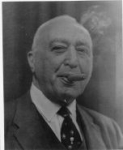I don't think it was sarcasm. I think it was a "not" inadvertently left out of the relatively long sentence.Bearded_One wrote:I think that there was an implied /s tag at the end of Raylo's post -- it was sarcasm.ThatMaskedMan wrote:Raylo wrote:Say what?I also think it is reasonable that when one is carrying less than the airline's own published guidelines that they should be yelled at, insulted, and/or be told they are in violation.
American Airlines took my medical equipment bag
Re: American Airlines took my medical equipment bag
The OSA patient died quietly in his sleep.
Unlike his passengers who died screaming as the car went over the cliff...
Unlike his passengers who died screaming as the car went over the cliff...
Re: American Airlines took my medical equipment bag
Yep, I mis-typed. I think the airline fee system has gone nuts, and passengers should not be yelled at because of it.
Sorry for any confusion
Sorry for any confusion
- spitintheocean
- Posts: 180
- Joined: Thu Feb 26, 2009 10:47 am
- Location: Ottawa, Canada
Re: American Airlines took my medical equipment bag
Silver Pelt wrote:I get sleepy as soon as I sit in the airplane seat while still at the gate; I think that's a combination of years of conditioning/practice and learning to take catnaps when appropriate as a way to cope with my (undiagnosed) OSA. I'll have to see if that changes now that I'm getting restful sleep every night. Still, sleeping is a great way to kill time on a boring flight. It's not like I'm going to miss any great food or wonderful movies. I don't notice any problems at altitude. In fact, I don't snore while sitting upright or slightly reclined, so using xPAP in flight isn't an issue.Muse-Inc wrote:Hey, all you airline travelers, given the reduced air pressure in the cabin at cruising altitude -- do you get sleepy? Drink more caffeine? Walk around? Break out the xPAP and sleep? Not an issue?
Exactly what Silver Pelt said; I'm usually asleep before the plane leaves the tarmac. I should get him to write all my posts.
aah for the good old days of attractive stewardesses and a few cigarettes to pass the time.
_________________
| Mask: Mirage Quattro™ Full Face CPAP Mask with Headgear |
| Additional Comments: Settings: 17 - 19 - no EPR; CMS 50F Pulse Oximeter |
Life is something to do when you can't get to sleep.
Fran Lebowitz
Fran Lebowitz
Re: American Airlines took my medical equipment bag
I tend to agree.raylo wrote:Yep, I mis-typed. I think the airline fee system has gone nuts, and passengers should not be yelled at because of it.
Sorry for any confusion
First there was the age old lost baggage issue which resulted in a certain number of passengers taking everything onboard with them. That wasn't too bad since there were always many more passengers using checked baggage services.
Then came along the fee for checked baggage.
The end result... an increase in the carry-on luggage.
The airlines reaction... vigorously police the carry-on.
Me... I just want to get from point A to B safely and choose to not challenge the system or start waving copies of regulations at them. So, I pack valuables/essentials into carry-on and replaceable items into checked.
The last time I flew the folks at check-in actually tried to convince me to take everything as carry-on... saying that the bag I wanted to check would fit nicely onboard. I did not want to be lugging 2 bags through airports on my layovers... so I took my chances and paid the $15 fee. Ottawa, Ontario Canada all the way to Kochi, India... 4 flights... no lost luggage. It was a miracle.
_________________
| Mask: Swift™ FX Nasal Pillow CPAP Mask with Headgear |
| Additional Comments: AHI ~60 / Titrated @ 8 / Operating AutoSet in CPAP mode @ 12 |
Re: American Airlines took my medical equipment bag
The problem stems from the airline allowing too many and too large a carry on in the first place. Carry on should be restricted to one bag, something like 19" max, and used ONLY for equipment that can't be checked or personal items needed on the plane. The larger bag policy allows selfish and self-centered individuals to bring huge bags on the airplane, slowing up security lines, taking up all the overhead room, delaying departures while they struggle with their bags in the overhead and aisleway, and forcing the bumping of genuine-need spaceholders such as yourself. All so they don't have to wait a few extra minutes at the destination.
_________________
| Machine: DreamStation Auto CPAP Machine |
| Mask: AirFit™ F20 For Her Full Face CPAP Mask with Headgear |
| Humidifier: DreamStation Heated Humidifier |
| Additional Comments: Max pressure set at 15cm |
Re: American Airlines took my medical equipment bag
The problem stems from the airline allowing too many and too large a carry on in the first place. Carry on should be restricted to one bag, something like 19" max, and used ONLY for equipment that can't be checked or personal items needed on the plane. The larger bag policy allows selfish and self-centered individuals to bring huge bags on the airplane, slowing up security lines, taking up all the overhead room, delaying departures while they struggle with their bags in the overhead and aisleway, and forcing the bumping of genuine-need spaceholders such as yourself. All so they don't have to wait a few extra minutes at the destination.
_________________
| Machine: DreamStation Auto CPAP Machine |
| Mask: AirFit™ F20 For Her Full Face CPAP Mask with Headgear |
| Humidifier: DreamStation Heated Humidifier |
| Additional Comments: Max pressure set at 15cm |
Re: American Airlines took my medical equipment bag
In this context, I disagree. Assistive devices (crutches, canes, walkers, seeing-eye dogs, etc.) are allowed in the cabin because the person may need them to function during the flight. It's rare for a CPAP to be used in flight...or even ALLOWED to be used.raylo wrote: I'm thinking that sleeping is a function of daily life.
Right! I see you recognize the difference... There are clearly two (or more) categories, with differing rules. The Federal regulations make that distinction in their definition of "assistive device", even though AA doesn't and treats them the same.raylo wrote:...some of the other assistive devices and/or exceptions to the limits aren't meant for use on the flight, some may or may not be used on the flight.
And IF the use of CPAP "must be permitted" I would agree. It isn't. That's left entirely up to the airline.raylo wrote: I'm not trying to be a smart-aleck, but it would seem fairly obvious that if the use of a device must be permitted, than the device must be permitted.
I believe the language of the requirements makes a distinction between "assistive devices" and "medical equipment", with different rules for both.raylo wrote: All of this would make me believe that CPAP is regarded by the regulators as one of the assistive devices that must be permitted
Not sure I agree with "most". We've seen ONE example. But if your assumptions about the Federal regs were correct, why would the airlines need to "specifically include CPAP"?? It would be treated as an "assistive device" by regulation, not airline policy.raylo wrote: But anyway, most of the airlines, themselves, have written their policies to specifically include CPAP devices as exceptions to the cary-on baggage limits.
The OSA patient died quietly in his sleep.
Unlike his passengers who died screaming as the car went over the cliff...
Unlike his passengers who died screaming as the car went over the cliff...
Re: American Airlines took my medical equipment bag
These weren't my "assumptions" about federal regs (with the exception of one fairly large error on my part - see below). I got this stuff by going to government websites. There are now, apparently, quite a few travelers with CPAPS (according to a handful of TSA CPAP bomb-detection swabber people), so I would imagine that airlines want to let people get the info before arriving at the airport. I think they may also be trying to write and publish policies that show compliance with the regs.LinkC wrote:In this context, I disagree. Assistive devices (crutches, canes, walkers, seeing-eye dogs, etc.) are allowed in the cabin because the person may need them to function during the flight. It's rare for a CPAP to be used in flight...or even ALLOWED to be used.raylo wrote: I'm thinking that sleeping is a function of daily life.
Right! I see you recognize the difference... There are clearly two (or more) categories, with differing rules. The Federal regulations make that distinction in their definition of "assistive device", even though AA doesn't and treats them the same.raylo wrote:...some of the other assistive devices and/or exceptions to the limits aren't meant for use on the flight, some may or may not be used on the flight.
And IF the use of CPAP "must be permitted" I would agree. It isn't. That's left entirely up to the airline.raylo wrote: I'm not trying to be a smart-aleck, but it would seem fairly obvious that if the use of a device must be permitted, than the device must be permitted.
I believe the language of the requirements makes a distinction between "assistive devices" and "medical equipment", with different rules for both.raylo wrote: All of this would make me believe that CPAP is regarded by the regulators as one of the assistive devices that must be permitted
Not sure I agree with "most". We've seen ONE example. But if your assumptions about the Federal regs were correct, why would the airlines need to "specifically include CPAP"?? It would be treated as an "assistive device" by regulation, not airline policy.raylo wrote: But anyway, most of the airlines, themselves, have written their policies to specifically include CPAP devices as exceptions to the cary-on baggage limits.
This is from a DOT website on the subject (it can accessed by this link: http://airconsumer.ost.dot.gov/rules/rules.htm#FAQ)
UNITED STATES OF AMERICA
DEPARTMENT OF TRANSPORTATION
OFFICE OF AVIATION ENFORCEMENT AND PROCEEDINGS
WASHINGTON, DC________________________________________
May 13, 2009
Answers to Frequently Asked Questions Concerning Air Travel of People with Disabilities Under the Amended Air Carrier Access Act Regulation
...
53. May a carrier refuse to allow a passenger to stow on the aircraft any respirator, ventilator, CPAP machine or FAA-approved POC that does not have a manufacturer’s label indicating compliance with the standards of RTCA/DO-160 (current edition) or other applicable FAA or non-U.S. government requirements for medical portable electronic devices?
Answer: No. Carriers must allow passengers to carry a respirator, ventilator, CPAP machine or FAA-approved POC onboard aircraft, subject to applicable safety requirements, even if the device may not be used onboard the aircraft.
Here is what they have to say about what is an assistive device:
The TSA website simply lists CPAP with a group of "disability-related items."44. When may a bag containing an assistive device be counted towards a passenger’s carry-on bag limit?
Answer: An assistive device is any piece of equipment that assists a passenger with a disability to hear, see, communicate, maneuver, or perform other functions of daily life, and may include medical devices and medications. A carrier may count toward a passenger’s carry-on limit a carry-on bag containing items other than an assistive device. For example, a bag containing both medications related to the passenger’s disability and toiletry items or one in which a back brace and clothing are packed would be subject to the carry-on limit even though the medications and back brace meet the definition of assistive device. To the extent possible, all of a passenger’s assistive devices should be included in one bag. When making a determination as to whether an item qualifies as an assistive device, the carrier may ask the passenger how the item assists the person in performing a function of daily life.
The government doesn't seem to group assistive devices into categories based on whether the device is used in flight or not. Bone stimulators and CPAPS are in the same list as canes and such.
Since May 13, 2009 it would appear that an airline can refuse to allow the use (but not carrying-on) of CPAP if it isn't labeled as meeting FAA guidelines, but the airlines are "encouraged" to allow use. (My bad)
We have seen more than one example of airline policies posted (American and Continental). Southwest, Delta, Jet Blue - all also specifically allow cpap in addition to other carry-ons. United refers folks to the TSA web page. USAir, well... uh let's just say there website info on this is sparse about what you can do and heavy on what you can't - CPAPs aren't mentioned (they do say that they will be hiring extra staff to monitor baggage compliance, eek!)52. May a carrier refuse to allow a passenger to use on the aircraft any respirator, ventilator, CPAP machine or FAA-approved POC that does not have a manufacturer’s label indicating compliance with the standards of RTCA/DO-160 (current edition) or other applicable FAA or foreign government requirements for medical portable electronic devices?
Answer: Yes. Carriers may refuse to allow a passenger to use a respirator, ventilator, CPAP machine or FAA approved POC onboard the aircraft if the proper manufacturer’s labeling is not present on the device. However, we would encourage carriers to voluntarily conduct the necessary tests on a particular respirator, ventilator or CPAP machine model that is not labeled, in order to determine its compliance with the applicable safety standards and allow passengers to use those devices found to be safe on its aircraft. We also encourage carriers to allow the use of POCs on aircraft in accordance with the guidance contained in FAA Information for Operators InFO 090POC (May 1, 2009) at
http://www.faa.gov/other_visit/aviation ... o09006.pdf. If the manufacturer has already tested the device and it meets the RTCA standard, despite the device not being labeled, the carrier may voluntarily accept the device for use in the aircraft cabin without performing additional tests.
Re: American Airlines took my medical equipment bag
Indeed they do. So? That list is merely things allowed thru the TSA checkpoint, as it clearly indicates.raylo wrote:The TSA website simply lists CPAP with a group of "disability-related items."
Now look below that at another list which, presumably, further categorizes your list:
Mobility Disabilities
Hearing Disabilities
Visual Disabilities
Hidden Disabilities
Pacemakers, Defibrillators, Other Implanted Medical Devices, & Metal Implants
Continuous Positive Airway Pressure (CPAP) Machine
Medical Oxygen and Respiratory-Related Equipment
Diabetes
Medications
Assistive Devices and Mobility Aids
Prosthetic Devices, Casts, and Body Braces
Walkers, Crutches, and Canes
Augmentation Devices
Orthopedic Shoes, Support Appliances, and Exterior Medical Devices
Dressings
Service Animals
Children with Disabilities
Medical Conditions and Special Situations
Military Severely Injured Program
IF CPAP were an "Assistive Device" one would think they'd list it there instead of "Hidden Disabilities".
Thank you providing a reference indicating the government does not consider CPAP an "assistive device".
The OSA patient died quietly in his sleep.
Unlike his passengers who died screaming as the car went over the cliff...
Unlike his passengers who died screaming as the car went over the cliff...
Re: American Airlines took my medical equipment bag
If you are arguing that the TSA, on their website uses the term "assistive devices" to separate out mobility devices, you may have a point. However the DOT information that I quoted above defines assistive devices more clearly than gleaning a definition from a categorized list of items that have one thing in common (that they are allowed in the cabin of aircraft). The rule issued by the DOT absolutely says that CPAPs may not count against the carry-on baggage limit. Check the documents I have posted and cited.LinkC wrote:Indeed they do. So? That list is merely things allowed thru the TSA checkpoint, as it clearly indicates.raylo wrote:The TSA website simply lists CPAP with a group of "disability-related items."
Now look below that at another list which, presumably, further categorizes your list:
Mobility Disabilities
Hearing Disabilities
Visual Disabilities
Hidden Disabilities
Pacemakers, Defibrillators, Other Implanted Medical Devices, & Metal Implants
Continuous Positive Airway Pressure (CPAP) Machine
Medical Oxygen and Respiratory-Related Equipment
Diabetes
Medications
Assistive Devices and Mobility Aids
Prosthetic Devices, Casts, and Body Braces
Walkers, Crutches, and Canes
Augmentation Devices
Orthopedic Shoes, Support Appliances, and Exterior Medical Devices
Dressings
Service Animals
Children with Disabilities
Medical Conditions and Special Situations
Military Severely Injured Program
IF CPAP were an "Assistive Device" one would think they'd list it there instead of "Hidden Disabilities".
Thank you providing a reference indicating the government does not consider CPAP an "assistive device".
- billbolton
- Posts: 2264
- Joined: Wed Jun 07, 2006 7:46 pm
- Location: Sydney, Australia
Re: American Airlines took my medical equipment bag
I have trouble with your absolutely interpretation, as there are indeed various conditions (described in the more detailed explanatory notes) under which it may not apply in all circumstances. Its a fairly clear statement of general intent but it is not absolute in all circumstances.raylo wrote:The rule issued by the DOT absolutely says that CPAPs may not count against the carry-on baggage limit. Check the documents I have posted and cited.
Also, as always, flight safety considerations for specific flight conditions can override the intention of many other DOT rules.
Cheers,
Bill
-
Bearded_One
- Posts: 597
- Joined: Fri Nov 17, 2006 9:35 am
- Location: Northern Virginia, near DC
Re: American Airlines took my medical equipment bag
I am not sure what that list is saying because it also includes Medical Oxygen. Many airlines have very strict restrictions and requirements regarding the use of oxygen during a flight and some airlines even prohibit passengers from carrying oxygen bottles on the airplane.
Re: American Airlines took my medical equipment bag
Oh my... I can only imagine the scene at an airport while an xPAP user whips out his/her laptop and starts tossing all these rules & regulations at staff.
Unfortunately, they have the trump card when it comes to this... and will tell that person how it will be and if they cannot comply then they will not fly.
Personally, I cannot see myself using the machine onboard... but I will still bring it with me in my ONE carry-on.
Unfortunately, they have the trump card when it comes to this... and will tell that person how it will be and if they cannot comply then they will not fly.
Personally, I cannot see myself using the machine onboard... but I will still bring it with me in my ONE carry-on.
_________________
| Mask: Swift™ FX Nasal Pillow CPAP Mask with Headgear |
| Additional Comments: AHI ~60 / Titrated @ 8 / Operating AutoSet in CPAP mode @ 12 |
Re: American Airlines took my medical equipment bag
My "absolutely" was intended to signify that the document in question says what it says (it modifies "says").billbolton wrote:I have trouble with your absolutely interpretation, as there are indeed various conditions (described in the more detailed explanatory notes) under which it may not apply in all circumstances. Its a fairly clear statement of general intent but it is not absolute in all circumstances.raylo wrote:The rule issued by the DOT absolutely says that CPAPs may not count against the carry-on baggage limit. Check the documents I have posted and cited.
Also, as always, flight safety considerations for specific flight conditions can override the intention of many other DOT rules.
Cheers,
Bill
It is a "fairly clear statement of general intent" that has a single exception listed.
Now in regards to whether a CPAP should be a guarenteed an overhead bin space, there are a couple of guidelines to follow:A carrier may count toward a passenger’s carry-on limit a carry-on bag containing items other than an assistive device. For example, a bag containing both medications related to the passenger’s disability and toiletry items or one in which a back brace and clothing are packed would be subject to the carry-on limit even though the medications and back brace meet the definition of assistive device.
The point I am trying to make, is that it is clear that the TSA allows CPAPs on board because they see them as necessary medical devices, the DOT has rules that say they are not to be counted toward carry-on baggage limits. This, especially combined with published airline policy should be enough to feel confident about getting on plane with a CPAP.46. Is a carrier obliged to make room for a passenger’s assistive device in an overhead compartment or other in-cabin stowage area if all compartments are full by the time the passenger boards the aircraft?
Answer: Carriers must offer pre-boarding to passengers with a disability who self-identify at the gate as needing to stow accessibility equipment (see section 382.93). If a passenger with a disability does not self-identify and take advantage of the opportunity to pre-board, and all overhead compartments are full by the time the passenger boards, the carrier would not be obliged to remove and check carry-on items of other passengers in order to stow the assistive device in the cabin. Although not required by our rule, in situations where such a passenger would need to use the assistive device during the flight (e.g., a cane used to walk to the aircraft lavatory), we would encourage the carrier to ask other passenger(s) to agree to gate check an item and allow the passenger to stow this device in the cabin despite the passenger’s not having pre-boarded.
I agree that on the plane during the boarding prcess my not be the time to waive papers or crank up the computer for websites. But the airlines should be taken to task at some point for violating federal rules and their own policies. It is easier to pack so that you know you will be able to fly under the radar, but even that is much more difficult now. According to some flight attendants, what you need to carry on better fit under your seat if the bins are full or you may have to check it, no matter what it is. People stopping to unpack items doesn't make for an orderly or timely process. Berating people who have acted within the guidelines issued by the government and the airline itself seems a bit harsh.
How about if the airlines make sure they follow the rules and come up with procedures to keep themselves in compliance? For their paying customers.
Re: American Airlines took my medical equipment bag
I wouldn't worry about that, at some airlines they're the most profitable customers. I think about eight carriers now charge severely obese passengers for two seats.LinkC wrote:I hope they don't start tossing off fat guys in the name of "flight safety"!!!




















